For some reason, turnips are less popular than many other root vegetables (except, apparently, in Vermont where the Gilfeather turnip is the official state vegetable). I get why we love our potatoes and carrots and beets. And even radishes get some salad love. But what about the humble, homely turnip? Why isn’t it getting its culinary due?
One reason might be its hybrid nature. The turnip is a carbohydrate-rich root vegetable, but not as full of calories (and hence not as sweet) as some of the starchier or more sugary roots. It’s also sharp like a radish, but not as sharp, especially when cooked.
Secondly, turnips suffer from classism. Even back in ancient times (turnips are among the world’s oldest cultivated vegetables), turnips were seen as second-class, poor people’s food (classical classism). Romans used to hurl them at people they didn’t like. Charles Dickens used the word as an insult, referring to a stupid person. And it sure didn’t help turnips’ popularity when, at the end of Gone with the Wind, a starving Scarlett O’Hara dug a turnip out of the ground, and rather than taking a bite like a less dramatic person might have done, fell down sobbing, then shook it at the sky and declared, “As God is my witness… I’ll never be hungry again!”
And thirdly, the turnip is a pretty white root, and there’s an incorrect belief out there that all white foods lack nutrition. While that’s pretty much true for white flour and sugar, there are plenty of foods that come from the ground that are white or white-ish and full of health-promoting compounds — mushrooms, cauliflower, garlic, and onions join turnips in representing this category.
So in this article, we’re going to explore why turnips deserve more love and attention, their health benefits, and how to cook and use them in recipes. But if you want to learn how to accurately hurl them at people you don’t like, you’re on your own.
What Is a Turnip?
A turnip is the edible taproot of the Brassica rapa subspecies rapa, similar to other taproot vegetables like beets, radishes, parsnips, and carrots. They grow straight down in one single structure, which serves as the nutrient storage unit of the plant. The name ‘turnip’ comes from the Old English “turned neep” — that is a neep (root veggie) turned on a lathe (hence the circular striations on its surface that run parallel to the ground).
The turnip is a comparatively large root veggie, often reaching three inches in diameter at its thickest. Both the leaves and root are edible, although to some palates they can taste fairly harsh, or at least intense. Turnip greens are earthy and slightly spicy, similar to leafy greens such as arugula and mustard greens.
Typically, the turnip root is somewhat bitter, with spicy, radish-like flavor notes, though a good turnip that’s spent some time in cold soil can actually be surprisingly sweet. So when it comes to taste, don’t put all your turnips in one seasonal basket (so to speak) — save some for a truly hard frost to sweeten them up. When cooked, some of the starches turn to sugar, also giving turnips a sweeter, earthier taste.
If you recognize the “Brassica” part of their botanical name, you’ll realize that turnips are members of the cruciferous family, which also includes kale, broccoli, cauliflower, cabbage, radish, and many other vegetables.
Types of Turnips
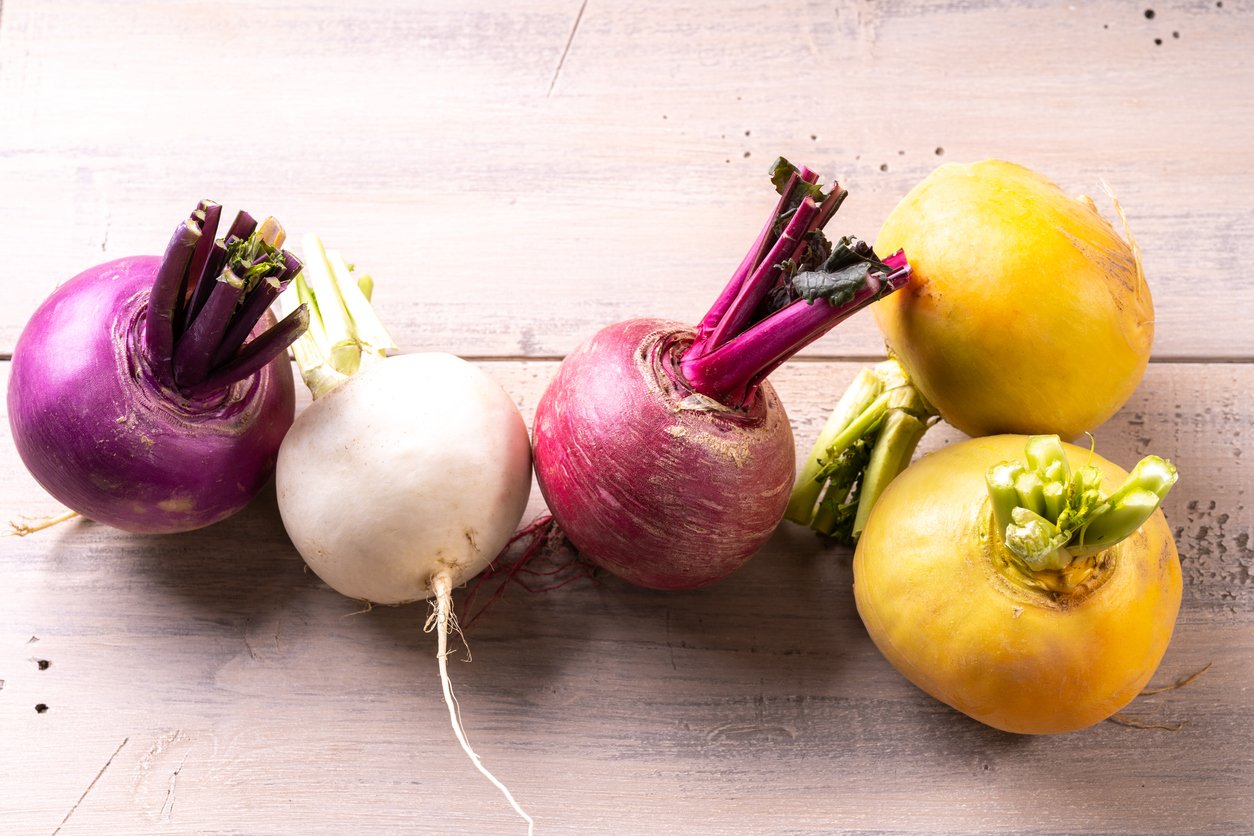
Turnips come in many varieties and colors. Purple and white turnips are the most common, but you can also find red, yellow, and green turnips, especially at farmers markets and in specialty seed catalogs.
Interestingly, turnips appear to have been domesticated twice, independently, in both Europe and Japan. The two variants differ in terms of time to flowering, the shape of their leaves, and how they respond to warmer temperatures.
Purple- or red-topped European turnips are the most commonly found turnip types. They’re also usually the largest turnip types.
The most popular Japanese variety is the Hakurei, or Tokyo turnip. Small and white, gardeners favor it for its speedy development. You can go from seed to salad in less than six weeks.
Fun fact: Jack-o’-lantern faces were originally carved into turnips during the Celtic festival of Samhain, which eventually became Halloween. They were even hollowed out and turned into lanterns, with candlelight illuminating their pale flesh to ward off evil.
Turnip Nutrition Facts
Turnips are a good source of vitamin C and potassium and are also high in an important prebiotic fiber called inulin.
In one cup of cooked and mashed turnips, you’ll find the following nutrients:
- Calories 50.6 kcal
- Protein 1.6 g
- Carbohydrates 11.6 g
- Fat 0.2 g
- Fiber 4.6 g
- Vitamin C 44% DV
- Vitamin B6 8% DV
- Folate 5% DV
- Calcium 8% DV
- Magnesium 5% DV
- Potassium 12% DV
- Phosphorous 6% DV
- Manganese 8% DV
Turnip greens are themselves a nutritional powerhouse, high in vitamin C, folate, calcium, copper, and manganese. Plus, a single cup of chopped turnip greens provides over 100% of the daily value for vitamins A and K1.
As cruciferous vegetables, turnip roots contain the potent antioxidant sulforaphane — about 120 mg per cup. This puts them right up there with reigning champions kale and kohlrabi (both at 134 mg per cup), and well above broccoli (88 mg per cup).
Turnip roots and greens also contain numerous phytochemical compounds associated with human health, including glucosinolates, isothiocyanates, and flavonoids. And purple turnips contain anthocyanin antioxidants, which give them their purple color.
Turnip Health Benefits
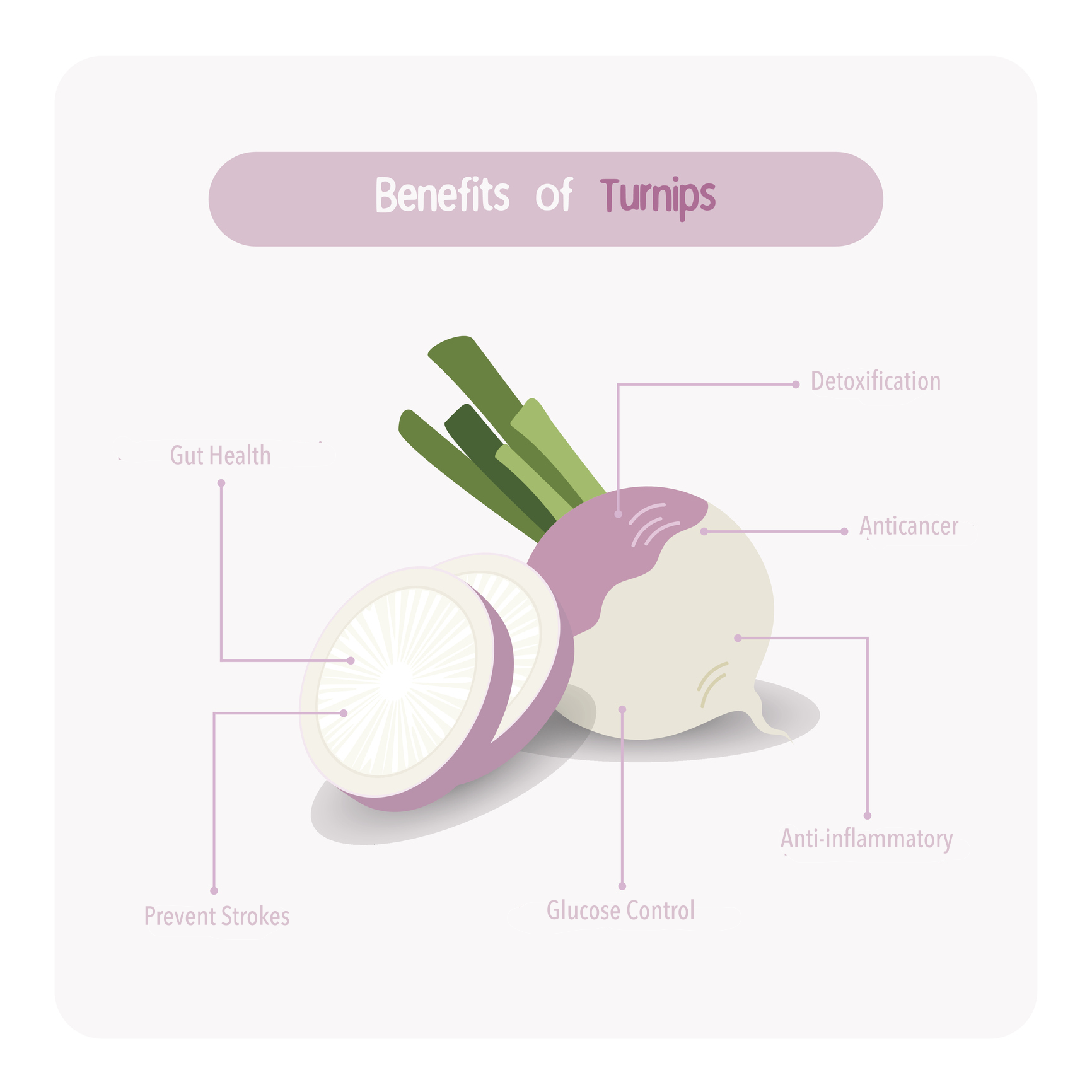
With all those vitamins, minerals, phytochemicals, and fiber, turnips should be really good for you. And that’s what we find when we take a peek at the scientific literature.
Cardiopulmonary Benefits of Turnips
According to traditional Tibetan medicine, turnips can help reduce fatigue, and they can detoxify and tone the body. One mechanism by which these benefits might accrue is promoting hypoxia tolerance, which is a fancy way of saying the ability to function in conditions of low oxygen. This relates to heart health in that more efficient use of oxygen means that the heart doesn’t have to pump so hard, and the person is less likely to “run out of breath.”
A 2016 study compared two groups’ performance on a treadmill test after receiving either turnip or radish powder twice a day. Various measures of health were found to be stronger in the turnip group, including anaerobic threshold (basically, the point at which breathing becomes labored and all conversation devolves into grunts and facial expressions), peak O2 pulse, and Vo2 max (maximal oxygen uptake).
A 2021 study looked at the biochemistry of the Tibetan turnip’s effect on cardiovascular functioning by running in vitro assays. If you feel like reading the abstract, which includes lots of phrases like “the functional monomer of B. rapa L. exerted a neuroprotective effect against OGD/R-induced HT22 cell injury,” you can get the full story. If not, the punchline is that the turnips appear to reduce inflammation and protect the body from cerebral strokes.
Turnips and Cancer
A 2019 review article reported that turnips perform potent anticancer activities, thanks at least in part to their high concentrations and wide varieties of glucosinolates and isothiocyanates. Many of the active constituents travel through the body scavenging free radicals before they can damage cells in ways that could lead to tumor growth.
One of the best-studied mechanisms whereby glucosinolates can prevent cancerous activity is apoptosis, or programmed cell death. Normal cells will self-destruct when they become old or injured, for the good of the organism. One of the hallmarks of cancerous cells is a selfish refusal to self-destruct. Glucosinolates from veggies like turnips appear to trigger apoptosis in these “vampire” cells (like a silver turnip through the heart, I guess).
Big Pharma manufacturers are probably trying to synthesize these compounds into dietary supplements that show evidence of benefit (and that they can sell for a profit). But you don’t need to wait or depend on that — you can ingest a bunch of turnips in their whole food state right now.
Are Turnips Good for Your Gut?
While many people obsess over whether they’re getting enough protein, there’s another nutrient we almost universally underconsume — fiber. In particular, most people are severely lacking in prebiotic fiber, which is the main source of nourishment for the microbiota in the gut, especially the large intestines. And turnips are among the foods highest in several types of prebiotic fiber, including inulin.
In 2021, the FOOD4GUT study (I’m not shouting — that’s actually the name of the study, capitals and all), gave 24 people either inulin or a placebo for three months. The inulin group was also given recommendations and recipes for other foods rich in prebiotics, including turnips. At the end, the prebiotic-enriched and encouraged group (via poop samples) had lower markers of inflammation and larger populations of beneficial bacteria.
One concern with lots of the brassica foods we eat is that we cook them, which deactivates the enzymes that can help us digest them. One of these enzymes, myrosinase, is required to convert glucosinolates into the anticancer and anti-inflammatory compounds that can protect from disease. But recent discoveries suggest that you don’t need to eat your turnips and broccoli and kale raw if you tend to eat a lot of cruciferous veggies.
It turns out that your microbiome, if it’s well-fed by prebiotics, can actually do the job of myrosinase and help you get the most nutritional value out of even well-cooked brassicas.
Turnips and Type 2 Diabetes
The first treatment option for many cases of type 2 diabetes is the drug metformin, which acts on several pathways to stabilize blood glucose. Turnip leaves contain compounds that appear to do a similar thing, which led researchers to wonder if the two taken together would enhance or interfere with the other’s functioning.
In a 2018 rat study (our view on the use of animals in medical research is here), both metformin and turnip leaf extract separately lowered fasting blood glucose in diabetic rats. When combined, their effects multiplied, with turnip leaf significantly improving the blood sugar-lowering activity of metformin. And together, they lowered the concentrations of some liver enzymes (essentially returning the liver to close to normal function) and attenuated damage to liver cells.
Turnip roots also help with blood glucose control, both by improving the efficiency of glucose transportation (so the sugar doesn’t remain in the blood) and by promoting the activity of an enzyme that balances insulin and its “opposite” hormone, glucagon, which increases blood sugar levels.
Are Turnips Anti-Inflammatory?
Possibly! A 2011 mouse study found that arvelexin, a compound derived from turnips, reduced inflammatory markers and mortality in mice injected with a toxin (the innocently-named LPS-stimulated RAW 264.7 macrophage). Other studies have also found arvelexin and other biologically active compounds in turnips to have similar anti-inflammatory effects.
How to Cook Turnips & Use Them in Dishes
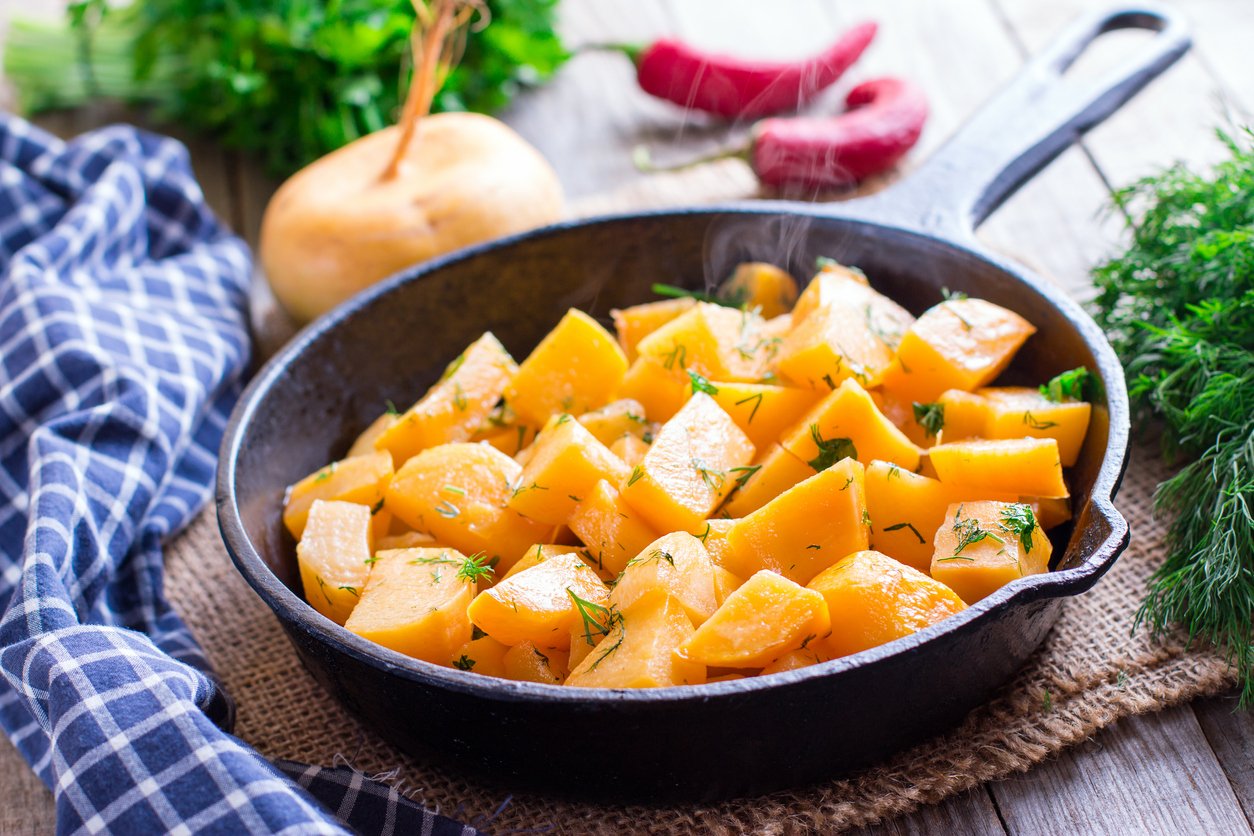
As befits a humble and hardworking vegetable, there are many different ways to prepare turnips. Some of the most common ways to cook turnips include boiling, steaming, roasting, and baking.
If you’re new to turnips, one shortcut is to think of them as lathe-sculpted potatoes. You can mash turnips and also puree them into thick soups, bake them into fries, and cube them for casserole dishes, breakfast hashes, dairy-free gratins, and anywhere else you might find cubed or diced potatoes. Turnips can add variety and flavor to your rotation of fall or winter dinner recipes or side dishes.
Unlike potatoes, you can also eat turnips raw. Simply peel the skin and slice or grate the root into salads. Or pickle them (we have a recipe for you, below)! As we saw above, Japanese turnips are especially good raw.
Here’s a helpful video demonstrating the art of peeling turnips:
https://www.youtube.com/watch?v=LFcMc2oAA2c
And finally, if you buy your turnips with the greens attached, you can use turnip greens like other leafy greens, raw or cooked.
Turnip Recipes
The turnip can be a favorite fall and winter root vegetable thanks to its earthy flavor and down-home versatility. Turnips are an unexpected flavor chameleon, transforming into tasty side dishes that pair well with robust and tangy flavors and various herbs and spices. Our turnip recipes offer three deliciously creative ways to enjoy them and are loaded with nutrients that are too good to pass up! Whether you are a tried-and-true turnip fan, or you’re meeting this root veggie for the first time, we’re certain you will enjoy these delicious turnip recipes — and can’t wait to read your comments!
1. Turnip and Potato Mash
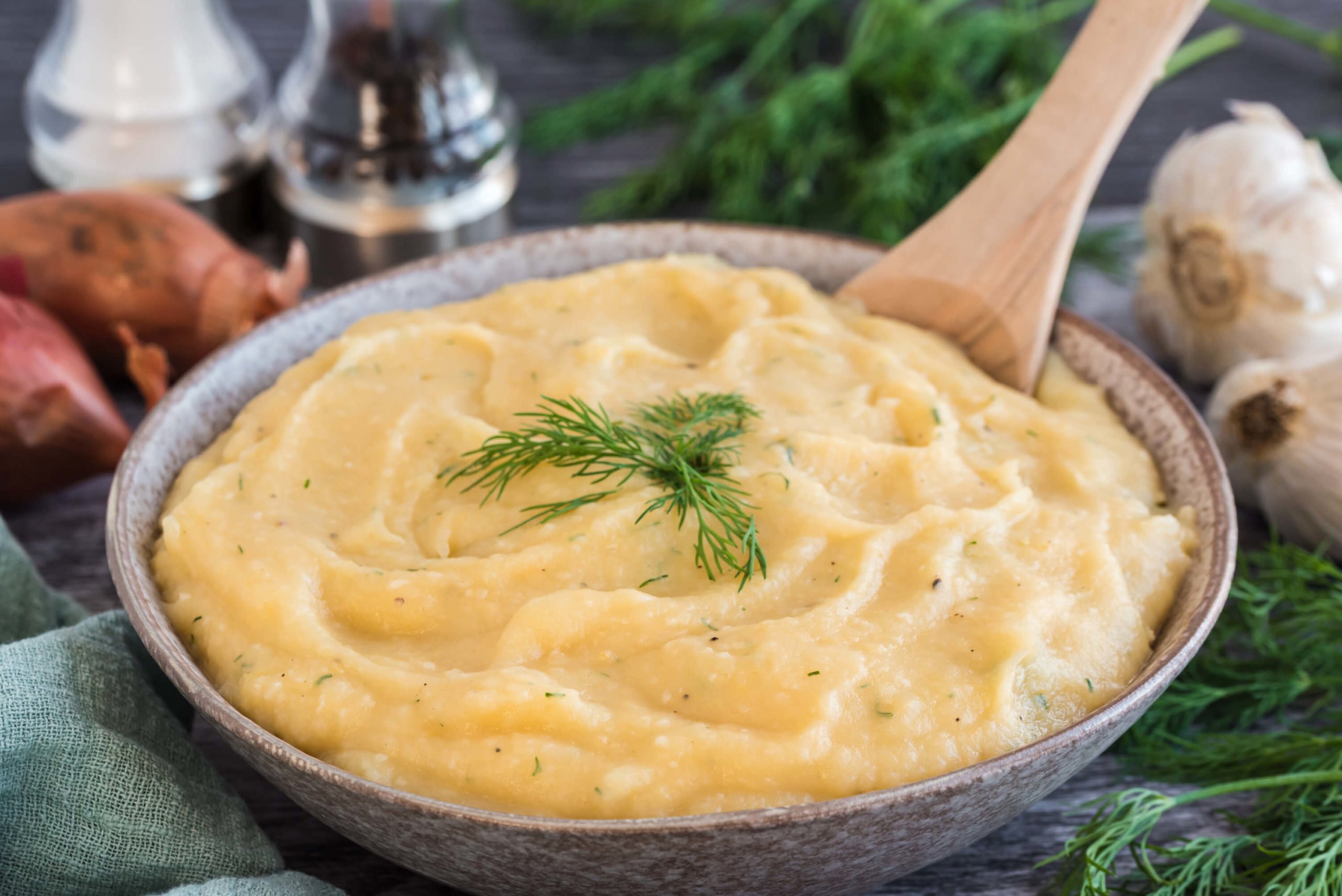
Turnips and potatoes are a mash made in heaven! These two root vegetables create a uniquely creamy side that is a delicious update to the classic mashed potato. Turnips add a savory and slightly bitter yet peppery taste, which brings out the earthy flavor and texture we love about potatoes. Whether you’re new to turnips or are a tried-and-true turnip aficionado, this creamy dish is certain to delight your taste buds!
2. Sweet Mustard Roasted Turnips
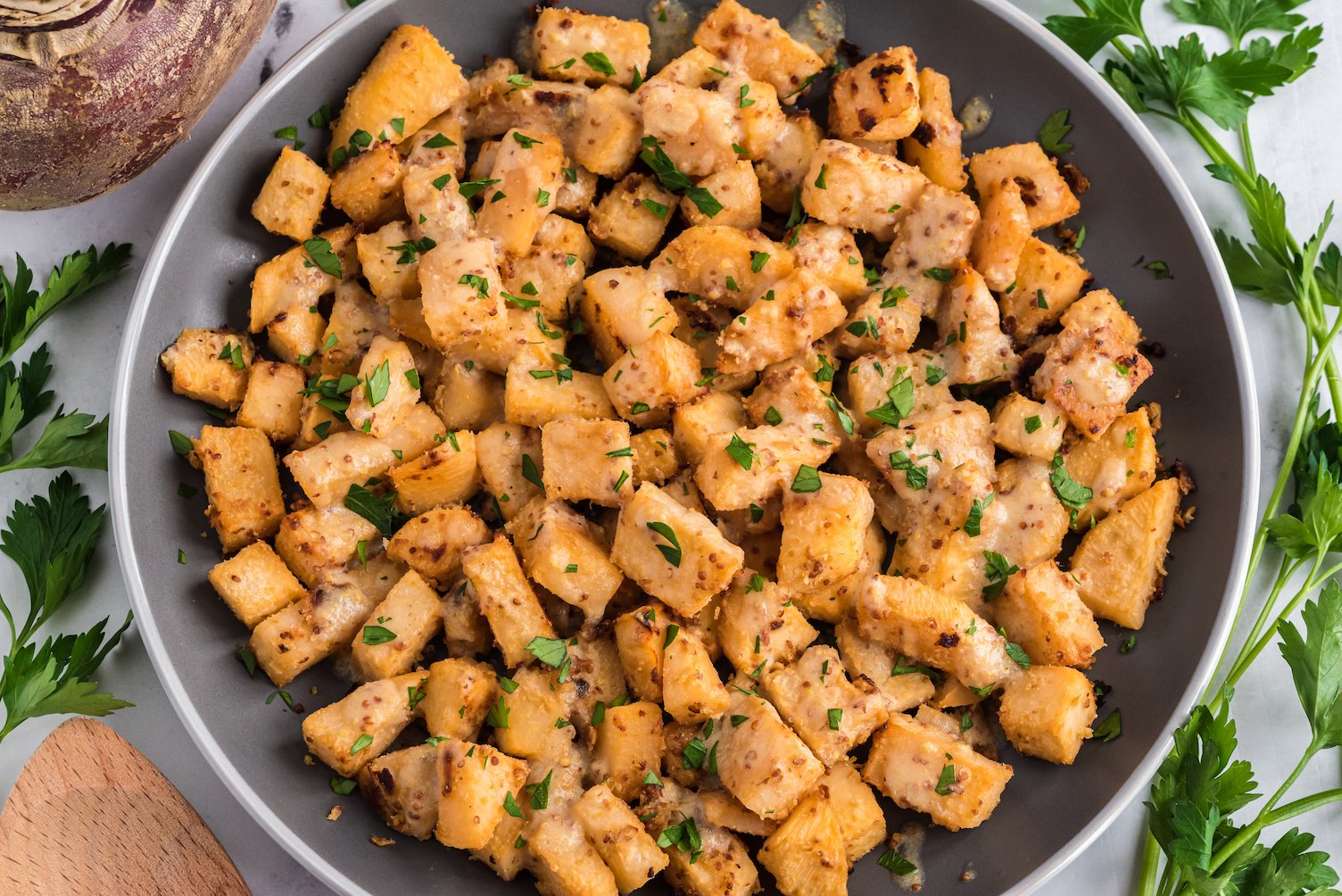
Turnips transform into a delectable side when they’re coated in a sweet and tangy mustard dressing then oven-roasted until tender. As they cook, the turnips develop a sweet caramelized exterior, a pleasant tender interior, and a deep earthy flavor that is simply divine with the Sweet Mustard Dressing. If you weren’t a turnip fan before, this recipe may just convince you to see turnips in a new light!
3. Pickled Turnips
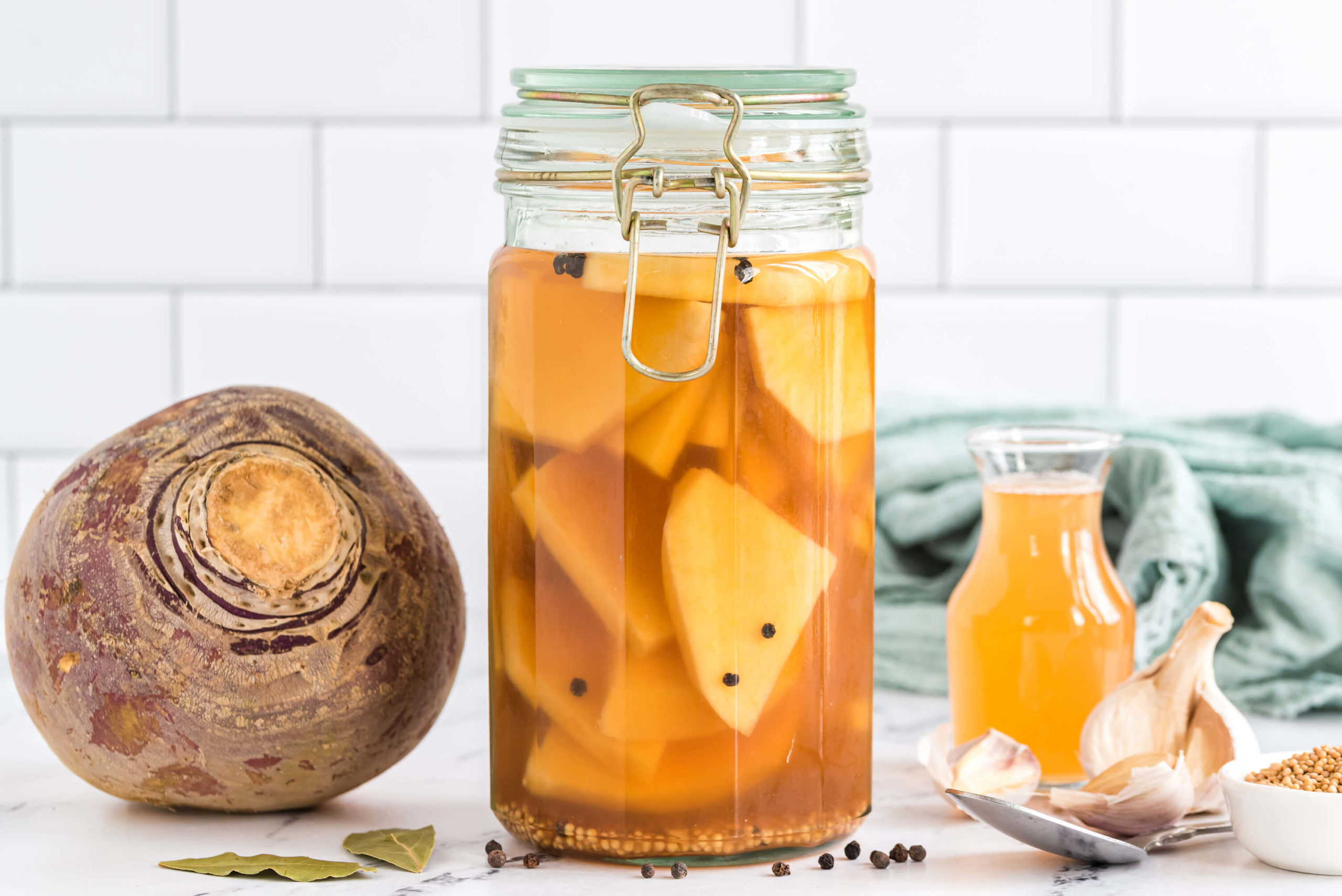
Pickled Turnips are a delicious way to highlight the earthy and sweet flavor, as well as the crisp texture, of a turnip. These tangy turnips make for a wonderful pickled veggie option and are an excellent addition to any savory plant-based dish that needs a bit of tang and crunch.
Turn Up for Turnips!
Turnips are among the oldest cultivated root vegetables, although at this moment they are sadly underutilized and underappreciated (except in Vermont!). But that’s too bad because, in addition to their versatility, they provide many health benefits due to their high fiber content, nutritional composition, and phytochemicals. You can cook and use turnips in many different ways, similar to potatoes, and many of those methods can reduce the roots’ sharp and distinctive taste. Once you give them a fair chance by including them in your veggie rotation, you may soon become hip to these wonderful lathe-turned neeps!
Tell us in the comments:
- Have you eaten turnips? How were they prepared? What did you think of them?
- Do turnips appear in any recipes in your family or ethnic heritage?
- What’s one way you’d like to try turnips in the coming season?
Featured Image: iStock.com/Studio Grand Web

